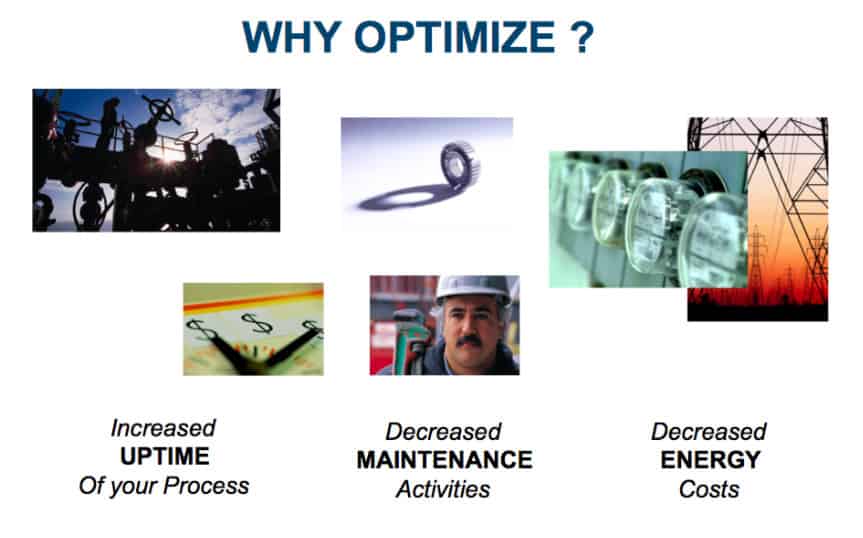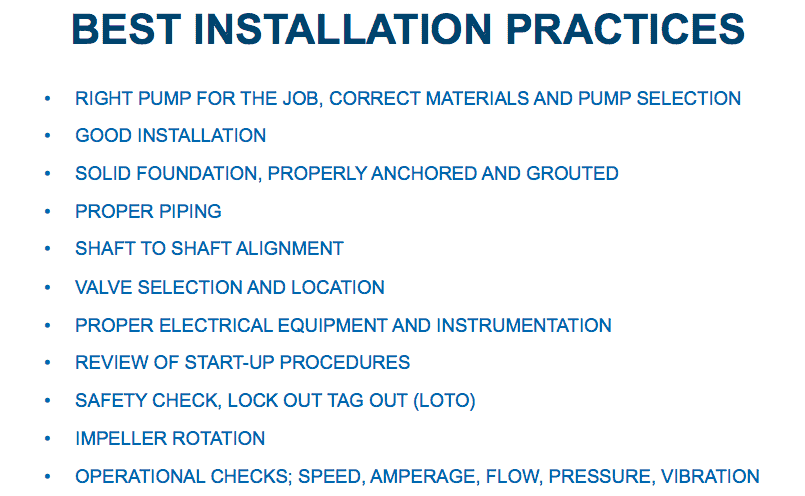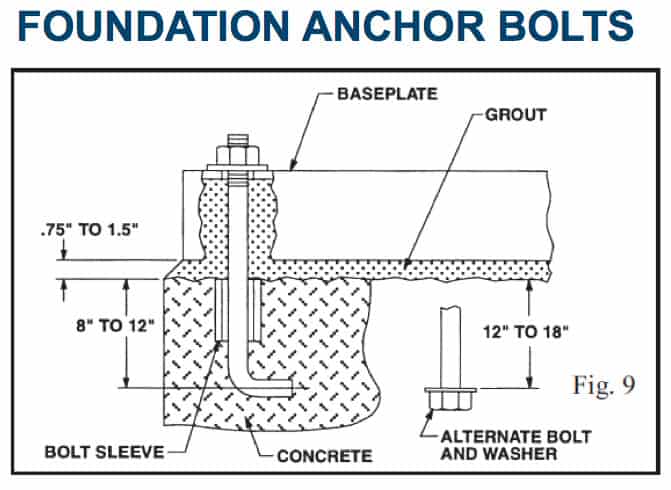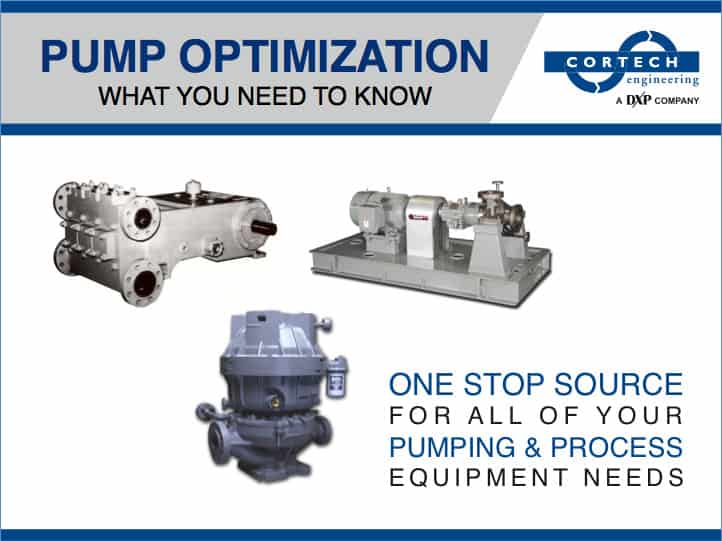“…Anywhere from 25-60% of the energy used in an industrial plant comes directly from the pump system itself.”
There are many different reasons to optimize your pump system performance. For instance, if you optimize or make it the best and most effective pump system it can be, you will increase the uptime of your process, decrease the amount of maintenance needed, and decrease your energy costs. Each of these outcomes can, over time, dramatically impact your profits and effects on the environment.
The reason it is so important to look at optimizing the function of a pump system is simply that anywhere from 25-60% of the energy used in an industrial plant comes directly from the pump system itself. All other factors that contribute to energy use in an industrial plant pale in comparison to the amount needed to keep the pump system up and running in a fully functioning manner.
If something were to go wrong with the system that could cause an increase in energy usage, the amount would be astronomical. And, even a perfectly functioning system may not be fully optimized.
So, how do you go about optimizing your pump system to make sure you are incurring all of these benefits and avoiding any excess energy usage?

The Benefits & Avoiding Excess Usage
First, it is important to understand the type of job that you are using a pumping system for. Whether it is for wastewater treatment, process liquids, slurry transfer, circulating plant water or any number of other types of pump systems, optimization can easily be achieved with the right tools and the right guidance.
There are many different factors involved in optimizing each of these types of systems and understanding what exactly it is that you want or need your system to accomplish is vital to the efficiency of your system.
Once the overall concept of your application is determined, the specific components that are included in your pump system can then be analyzed and properly chosen. Perhaps the most significant component within your system is the pump itself. There are two different types of pumps, each with its own separate and unique function:
Positive Displacement Pump: The first is a positive displacement pump, and the flow rate of the pump is directly proportional to the speed at which the pump is running. There are many different types of positive displacement pumps including screw pumps, rotary lobe pumps, diaphragm pumps, piston pumps, and others.
Centrifugal Pump: A centrifugal pump has a variable flow rate that is based on both the speed at which the pump is running and the diameter of the impeller.
Cortech can help you determine, based on your application and any other details regarding your pump system, which type of pump is best suited for your needs. On the surface, it can be difficult to decide which pump will ultimately provide you with true optimization, but discussing the possibilities with experts can clear up many of the issues.

What to Install & What to Consider
Then, you must decide which pump to install. You’ve decided which type of pump you need, but which pump within that category should you choose? It is at this stage in the process of optimization that your choices can have the most significant impact.
When looking at pumps, here are some questions to consider:
• How much energy do they use to run?
• How easy it is to get parts for repair or maintenance?
• How many instances of issues relating to abrasion or corrosion have been reported?
• Are there are continual maintenance issues that lead to increased costs?
• Are there are any utility rebate programs that apply to the pump you are considering purchasing?

While this is not an all-inclusive list, it is certainly a good place to start. It is also important to note that most companies are looking to improve on the system they already have in place; starting from scratch may not be a wise financial option. However, this same list applies to existing systems as well as new systems. If you have an existing system, see how your pump holds up to some of these concerns. There may be ways to update your pump to make it more efficient without replacing it in its entirety.
There are some clear and concrete signs to look for when checking to see if your pump system is performing inefficiently, which means it may be time for an upgrade. First, you will want to check the instrumentation on your system. Having instrumentation for flow, pressure, and power will allow you to control each of these settings for your specific application. A system that is customized is much more efficient than a stock system. Another issue that can cause inefficiency is running multiple pumps at full speed, particularly if they are missing the previously mentioned controls. While it may seem like running your pumps at full speed would be more efficient because everything is “getting done” faster, the reality is, full speed is often one of the most inefficient settings possible.
When the controls can be accurately and specifically set for each pump, the entire system will run closer to full optimization. This should also help decrease any downtime caused by frequent on/off cycling. By optimizing the flow and pressure of the system, it will not need to shut itself off to correct any misalignments or malfunctions. The system can then run continuously, as it is supposed to. At this point, the amount of energy used and the amount of downtime can be decreased. A few other things to look out for are highly throttled control valves, the presence of a bypass line, and any cavitation or system noise. Any or all of these things will contribute to the inefficiency of your pump system and hold it back from becoming completely optimized, as they are signs of system failures or malfunctions within the application.
In addition to noticing the possible issues above, there are many things that can proactively be done to optimize your pump system. First and foremost, the right pump needs to be chosen for your specific application. There are many different factors that need to be considered when choosing a pump, and Cortech can assist with the decision to purchase the pump that is designed to optimize your pump system. Once the pump is acquired, it must be installed properly. Each and every detail needs to be attended to. While anyone may be able to hook it up, only an expert can install it up properly. Without the expertise of an experienced pump installer, any misalignment could result, which will bear decreased efficiency. And because the pump is susceptible to certain movements during operation, the equilibrium could be thrown off if it is not properly installed and then anchored to a solid foundation.
Anchoring and grouting will help to keep every part in alignment to ensure it continually remains in the position it was installed. One of the most common misalignments is the shaft to shaft alignment. This, in particular, can cause a dramatic decrease in efficiency.
The materials used to install the pumps are also extremely important. One of the most important components used in your pump system is the piping. The proper piping must be used to control the flow of the system and to be able to withstand the potentially corrosive and/or abrasive slurries pumping through the system and also the highest possible pressure running through the system. Once the piping is in place, the proper electrical equipment and instrumentation will need to be determined and installed.
As discussed earlier, full speed at all times is not an efficient method for a pump system. It is important to provide your system with the needed ebbs and flows for the system to continuously run efficiently. Using the proper equipment and instruments can help to automate and streamline this process, removing the guesswork from the operator and freeing up manpower while still optimizing the system. Proper valve selection is also an important component in the installation of the entire pump system. Not only this, but the proper location for the valves must be determined, as well.

Finally, once everything is setup, it is necessary to have all operators read and become well-versed in the start-up procedures of the system, understand all of the safety precautions and procedures, and be aware of all the maintenance needed, including all operational checks that need to be performed on a routine basis. These final steps are crucial to the continued performance and optimization of the entire pump system.
Cortech has been working with companies to optimize their systems for almost 30 years. Their intimate knowledge of each and every one of these problems and solutions has been at the core of their success since they went into business.
Today, Cortech is a world leader in pump distribution and pump systems engineering. No matter what type of system you need optimized, Cortech is here with in-depth knowledge, superior customer service, and a wide expanse of experiences to be sure your system becomes the best it can possibly be.
Content courteys of DXP University
- Burlingame Engineers
- Cortech Engineering
- Turbo Machinery
- Turbo Machinery
- Burlingame Engineers
- Cortech Engineering

